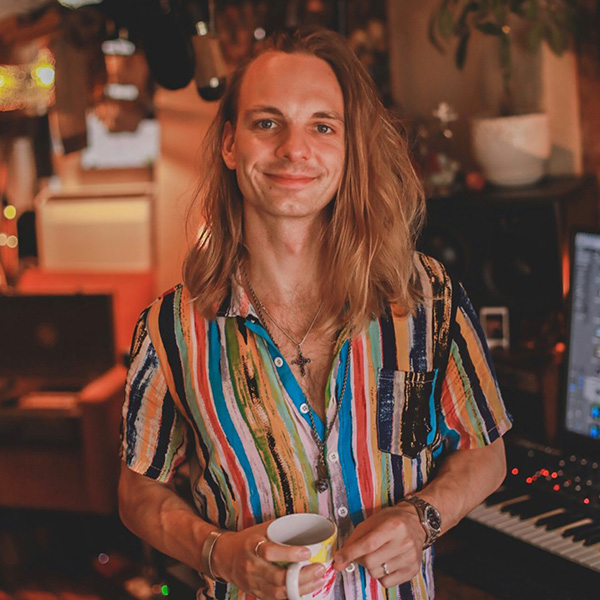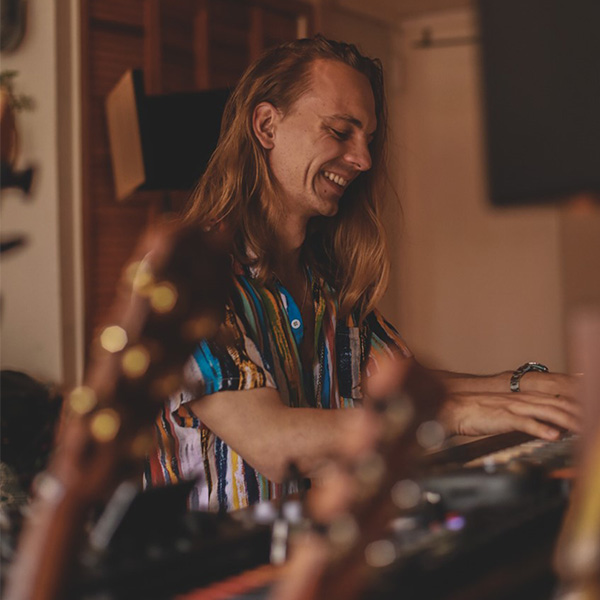This week, we catch up with NYC’s own Jannek Zechner. He talks with us about his debut record, mixing alongside Tony Visconti, and how Eventide aids in his creative process.

As a guitarist, you’re trained to pay close attention to detail, which in turn has probably influenced your clean, crisp mixes. What got you interested in mixing?
To tell the truth it started as a simple necessity. I couldn’t afford to get somebody else to mix the music I produced so I had to learn to bring it across the finish line.
It’s funny that you mention my guitar playing because, oddly enough, electric guitars are my least favorite thing to mix. I much prefer committing to guitar sounds in the production and recording process – and then barely touching it once I actively start mixing.
To this day I find that especially with instrumental and ambient music, the mixing can greatly influence the sound and even shift genres altogether. To me, the mixing process is just as creative as the production part because you have to allow each voice in the track to add its spark, with a lot of empathy for the surrounding voices. I find that to be an incredibly inspiring challenge.
When do you go from songwriting-mode to production-mode, and from production-mode to mixing-mode, etc.?
That’s a wonderful question and I spent a lot of time asking myself that as well. When you mix the same tracks you produced, you can easily get lost in constantly fixing musical material while you should actually be polishing the mix. I caught myself doing that on previous projects and not too long ago decided that it was an inhibiting way for me to work.
I mostly produce and create in Logic; and once I think I’ve recorded all the music and finished being creative with the arrangement and sound-shaping, I bounce everything out, move it to Pro Tools and just work on finessing the plain audio tracks in there. This has helped me tremendously as I can actively switch roles without ending in a feedback loop with myself.

That said, I view songwriting and production as the same process for me. I basically build the track as I write it, even when I co-write. I either use my sequencer to build quick and dirty grooves in the room or I lay down a few basic things to create a demo in an hour or so. Then I have a track for a co-writer to topline over and we can get inspired by sounds. I’m not much of a songwriter, I really consider myself a composer and I therefore very much see the process of creating sounds and scapes as part of the writing.
Do you ever go backwards when you’re in mixing mode?
I am absolutely set on what I have in front of me once I work in Pro Tools. I already go through absurd amounts of revisions in my production process within Logic (I guess most of us do) and I found in myself exactly what I saw in many of my peers: a struggle to finish an idea.
There’s one thing I learned from writing for ads, which is that you just must stick with an idea and ride it to the very end. If you execute an idea with confidence and ride it out, it will come out sounding its truest self and that’s what really matters. That doesn’t mean it’s good, but it means it’s finished. That’s sometimes more important. Unfinished ideas are dangerous for us musicians as they make us feel like we aren’t good enough to accomplish a finalized track. Therefore, it’s vehemently important in my eyes to finish every idea, no matter how odd, silly, short or long it is.
Do you find it’s easier to make important creative decisions by yourself or when there are other opinions in the room?
I love that question because I haven’t worked much with other people in the room during the last year and I’ve gotten so used to being by myself in the studio. Apart from working with my drummer and vocalist, I mostly sent music to other musicians and had them do their magic remotely.

I have to say though, there’s nothing better than bouncing ideas back and forth with someone in the room and having a feeling of ‘having to prove yourself’ a bit. I’m in the middle of reading a book on Geoff Emerick and his work with The Beatles. Clearly, every good idea he had came because something or someone in the room provoked him to overcome a challenge or prove that he had a solution for a problem. If that’s done in a supportive environment, then the sky’s the limit, as he clearly proved.
Working with Tony Visconti has brought out very similar ideas in me. It’s all about finding creative ways to get to a result that you or others have in their heads and that’s the creative inspiration I absolutely love.
What was your biggest takeaway from working with Tony Visconti on the Bowie remixes?
The first big reveal was listening to the individual stems. There are few places where you can get just as much inspiration as listening to Brian Eno’s individual synth tracks or Bowie’s isolated vocals as you could listening to the entire song. It’s just raw and magical, and it sparks a fire in me every time.
Technique and approach-wise I continuously find it inspiring how Tony loves bringing worlds together. We have to remember that he brilliantly used recorders on multiple rock records, and that approach shows in so many ways of his thinking. He’s unapologetic about taking the time to creatively explore a direction others would shy away from and loves using high-end outboard gear as much as free plugins that come with Pro Tools. He recently excitedly told me about how he used the Pitch II plugin on a delay to very cleanly give it some width and that sense of adventure about simple things is something I aspire to always keep in my heart the way he does.
What have you felt different about working on your debut album by yourself and not with others?
Well I’ve got to clarify here – apart from some adlib melody parts in “Liquify” I wrote everything by myself, but the album certainly came together with the help of dear friends. I had the pleasure of working in the same room with my drummer, which is always a great time.
Listen to Jannek Zechner’s debut album, Sunbow!
Working by myself has been revealing though because it’s easy to get distracted by yourself, and it takes me a bit of time to get into a flow state when I’m not around others. Whenever others are around I very much feel like a herding dog, trying to gather up the ideas and join them into something meaningful. When I’m by myself I don’t always have that intuition and it takes me a bit longer to move forward!
I’m sure a lot of my peers felt this way during the last year. Musicians are collaborative animals and while writing on your own is certainly an incredibly honest way of creating art, everything always turns out better when your friends get to add their flavor to it!
When working with FX, what’s your go-to for ultra-clean, and your go-to for ultra-weird?
For ultra-clean I go for my Bricasti. For ultra-weird I go for the H9000. I basically view the H9000 as an instrument in itself and often try to make the things I run through it become something entirely different once I’m done with it.

So does the H9000 fit into the songwriting process, the mixing process, or both?
The H9000 fits into my mixing process most and foremost. I like to use it when I am at a point where I say “ok, no more new material,” and then I run some tracks through the H9000 and new stuff comes out. I cheat my own rule here because it’s technically just a processing unit, but I then end up using it in creative ways, creating ‘new material’ of sorts.
I thereby expand my mixing process into a creative elaboration of the sounds I already committed to, which I absolutely love. I found myself working that way quite organically and just didn’t fight it.
When do you use one piece of equipment over another?
My H9 is a constant sibling to my Prophet Rev 2. It never leaves that chain because this combination gives me a plethora of sounds to access. I wrote most of my record with those two pieces of gear as well as an Organelle and my Echofix tape echo.

The H9000 is on a set of inserts and I mainly use it for mixing creatively. Once I find a sound I immediately commit it to audio so I can move on to finding the next sound.
I use Eventide plugins mostly when I need extreme solutions. Blackhole can be found in every one of my sessions and I love automating the Depth and EQ on it in order to give it an organic touch. TVerb is a part of all my session templates. It gets less phasey than the UAD Ocean Way plugin, I find. Lastly, the Newfangled plugins most often land on my mix bus when I don’t end up using my Neve Portico & Maag EQ4M. The Newfangled stuff is impressively flexible and it has never failed at making a track sound better.
What’s next?
Now that my debut album Sunbow is out I will spend some time promoting that, and I’ll be taking care of a few of my friends’ albums that I’m producing and mixing. I’ve been working on Donny McCaslin’s upcoming music, which has been unreal. He’s playing with his band that he also used on Blackstar: Tim Lefebvre, Jason Lindner and Mark Guiliana. Working on tracks that have that caliber of musicianship on it is absolutely mindblowing.
Then I have more music coming out myself starting November! Sunbow is part of a 3 album series that I call the “Sunbow Circle”. It’s inspired by the three states of mind we go through: the playful and eclectic mind, the state of meditative calmness and focus, and lastly the focused energy that arises after we nurture ourselves through the process of meditation and mindfulness.
Thanks for having me, it was a pleasure doing this interview and I’m looking forward to working with Eventide for many years to come!

Photo credits: Marth Brown (https://www.instagram.com/smwritingphotos/)
Find Jannek Zechner on social!
Personal Website: https://www.jannek.io/
Instagram: https://www.instagram.com/jannek.io/
Facebook: https://www.facebook.com/jannekzechner


